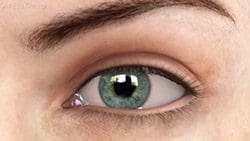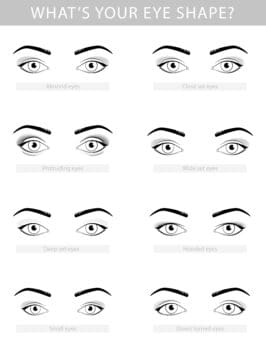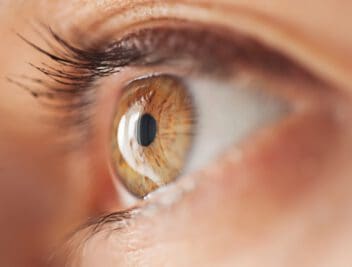Understanding Different Human Eye Shapes
Home /
Last Updated:
One of the features of the diverse variety of human faces is the differing eye shapes. In this article, we’ll be exploring the different eye shapes and how they may even affect our vision.
There are two components to eye shape: the shape around the eyes, which is a matter of bone structure and eyelid creases, and the shape of the eyeball itself, which is not always a perfect sphere.
Table of Contents

Most people might be oblivious to eye shape and not know what type of eyes they have, but it’s really easy to determine your eye shape on your own. Understanding your eye shape can even lead to a better understanding of potential vision issues.
How Vision Works
Vision is a complex process. The eye functions as nature’s own “camera,” as rays of light go through the cornea and into the eye. The cornea refracts these rays as they pass through the pupil.
The rays then go through the lens of the eye, eventually focusing on the retina at the back of the eye. The retina contains light-sensing nerves which we refer to as cones and rods, named after their distinctive shapes. Cones concentrate at the center of the eye, called the macula, and allow us to perceive colors and shape definition. The rods are around the outside of the macula, allowing us to have peripheral vision.
You deserve clear vision. We can help.
With 135+ locations and over 2.5 million procedures performed, our board-certified eye surgeons deliver results you can trust.
Your journey to better vision starts here.
The cones and rods take this incoming light and turn it into electrical impulses. These impulses then travel to the brain via the optic nerve, where the light we take in at last forms an image.
Different Eye Shapes

There are good reasons why the shape of your eyes is important, and not just because of what eye shadow and makeup looks right.
- Deep-set Eyes: Deep-set eyes make the brow bone appear more prominent since the eyeballs are deeper in the skull and larger.
- Monolid eyes: This type of eye does not have much of or any crease. On the surface, they are flat. This shape is most common in East Asia.
- Hooded eyes: The lid appears smaller with this type of eye. This is because there is an extra layer of skin that is over the eyelid crease, which droops down.
- Protruding eyes: With this type of eye, the eyelids appear to project outward in the eye socket area. There is also a condition known as exophthalmos, which causes bulging eyes, and is due to hyperthyroidism.
- Upturned eyes: This type of eye has an almond shape. At the outer corner, there is a natural lift.
- Down-turned eyes: At the outer corners, this type of eye has a slight drop.
- Close-set eyes: When the eyes are close set, the space between them is less than one eyeball width apart.
- Wide-set eyes: With wide-set eyes, the space between them is more than one eyeball width.
What Is My Eye Shape?
The first thing to look at if you’re determining your eye shape is to check if you have a visible crease in your upper eyelids when the eyes are open. If there’s no visible crease, you have monolid eyes. If there’s a visible crease when the eyelid is open, then other factors play into eye shape:
- If the colored part of the eye has a little white showing above and below and the eyelid crease is visible, your eyes are round.
- If the eye’s outer corners turn down, your eyes are down-turned.
- If you have a crease that is not visible due to a skin flap, you have hooded eyes.
- If the iris touches the bottom and top of the eyelid and the crease is visible, the eyes are almond-shaped.
- If there is a flick upwards of the outer corners of the eyes, you have upturned eyes.
If you are concerned about structural abnormalities within your eyes, that calls for a visit to an eye doctor. With a comprehensive eye exam and additional tests, such as a slit lamp exam, an eye doctor can determine if you have issues with different eye structures, such as the lens, cornea, or retina.
Bear in mind also that it’s possible for eyes to have combinations of the above shapes. A person may have upturned, almond-shaped eyes or deep-set, down-turned eyes. The various combinations, along with eye colors, make for a broad range of facial characteristics.
How Eye Shape Affects Vision

If your eyelid droops, it can affect your vision, in a condition referred to as ptosis. Even when fully open, the upper eyelid border falls lower than normal, and in severe cases ptosis can interfere with vision by partially obstructing the pupil.
Ptosis can affect either one or both eyes. Sometimes ptosis is present at birth, while other times it can occur over time as a result of nerve problems or different muscle diseases, such as myasthenia gravis.
Eyes affected by ptosis can appear smaller than they actually are, and the crease between upper eyelid and eyebrow can appear decreased. If ptosis causes the eyelid to droop enough, causing an obstruction of vision, the person might have to raise their eyebrows in order to see clearly, which can cause tension headaches.
The treatment for ptosis depends on the underlying cause. There are surgical options to correct the drooping, whether it is age-related or a condition from birth.
Eyeball Shape
In addition to factors affecting your eyelids and facial bone structure, eyeballs can also have different shapes, which can impact vision.
An eyeball may be either shortened or elongated. An elongated eyeball is associated with myopia or nearsightedness. With this condition, people have difficulty seeing objects that are far away.
Nearsightedness doesn’t affect close-up vision, such as with reading a book or using a smartphone. Only distance vision is affected. It is possible to experience headaches due to straining to see objects in the distance.
Myopia may also occur as a result of the cornea having an abnormal shape. In this case, the cornea curvature is too much for the length of the eyeball, or sometimes the lens of the eye is too thick. Why the eyeball may get too long remains unknown.
Conversely, an eyeball which is too short can also cause issues. A shortened eyeball is known as hyperopia or farsightedness. This condition makes it difficult to see objects that are up close, as with reading a book or viewing a smartphone. When this condition is significant, it can produce blurriness which may also affect distance vision.
Hyperopia can also be caused by a cornea with a curvature that is too slight. In this case, rays of light entering the eyeball may focus behind the retina, making it difficult to see close objects. A person with hyperopia is said to be far-sighted.
One further factor of eye shape can cause astigmatism or keratoconus.
Astigmatism is caused by an irregularly shaped cornea or lens, such as having a cornea that curves a bit more on one side than it does on the other. Astigmatism commonly results in blurry vision, and is one of the most common reasons for prescription glasses.
As for keratoconus, this is present when the cornea bulges outward, making more of a cone shape instead of a smooth dome. Once again, the chief symptom of keratoconus is blurry vision, with an additional sensitivity to light.

Does Eye Shape Affect Your Eye Color?
Eye color is a matter of the pigmentation of the iris. Depending on your genetic make-up, the iris may be any number of shades from brown to hazel to green to blue.
Your genetics determine the color of your eyes, dictating the amount and quality of melanin in some of the tissue forming the iris. Researchers came to this conclusion after discovering that a greater proportion of the genes responsible for the pigmentation of the iris are involved in melanin generation, transportation, and storage.
Melanin influences pigmentation in various body organs, and people with high concentration of this pigment generally have brown eyes. If you have blue eyes, that’s because you have lower amounts of melanin.
Eye shape has nothing to do with eye color, even though we may note that eye shape and eye color may be inherited. There are different genes controlling eye shape and facial bone structure, while the colors of our irises have their own genes.
You Can Change Eye Shape
Eye shape can be altered, thanks to advancements in surgical and non-invasive optical techniques. Generally, some people have the outward appearance of their eyes changed for cosmetic reasons, while others change the shape to correct vision problems.
If you wish to change the shape of your eyes, there are options worth considering, including blepharoplasty and LASIK surgery.
You deserve clear vision. We can help.
With 135+ locations and over 2.5 million procedures performed, our board-certified eye surgeons deliver results you can trust.
Your journey to better vision starts here.
Eye Shape and Personality
Many cultures have deep-rooted notions about the link between eye characteristics and personality.
For some examples, people with narrowly-set eyes are said to be untrustworthy, or people with large, wide-open eyes are said to have deep-running emotions. Other notions about eyes claim that you can detect malice or love by looking in someone’s eyes.
Just for the record, science has found no link between eye shape or eye color and personality or character traits. There doesn’t appear to be any purpose that eyes serve beyond letting us take in the beauty of the world around us.
Eye Teaming Issues
Your eyes work as a pair, relying on both eyes working in coordination. Eyes which do not team well together have a range of other issues, most of which may be correctable with vision therapy. When eye teaming issues are present, the cause is often a neurological issue. Vision therapy can help train the eyes and brain to work together in these cases.
“Lazy eye” is the common name for amblyopia. In this condition, one eye is not functioning as well as the other. Our brains defensively adapt to this condition by ignoring the output from one eye, effectively making one eye do all the work while the other one is “lazy.” This can be due to irregularities in the affected eye, such as astigmatism in just one eyeball.
Amblyopia may be easily treated by vision therapy, but it might also call for looking at the underlying issues, since lack of healthy eyesight in both eyes leads to this condition most of the time.. There is an urban myth that lazy eye must be treated in early childhood, but in fact lazy eye can be treated at any age.
Crossed eyes, otherwise known as strabismus, is where both eyes focus, but do not align in the same direction. They can appear to be looking inward, appearing crossed, or outward, commonly called “wall-eyed.” Eye alignment issues can also cause one eye to focus higher or lower in the field of vision than the other. Strabismus can be cause by problems with the muscles that control the eye movement, nerves connected to the eye, or the motor center in the brain that controls eye movement.
In some cases of strabismus, some form of vision therapy or corrective lenses can help. In other cases, actual surgery on the eye muscles may be required.
Other Eye Appearance Factors Which Your Eye Doctor Can’t Fix
There are other factors that impact the appearance of your eyes which have nothing to do with optometric issues. If you have any of these conditions, your eye doctor isn’t the person who can help with them.
Dark circles under the eyes have nothing to do with eye health. Instead, they are caused by a number of other issues, including genetics, dehydration, lack of sleep, or lifestyle factors. Dark circles under the eyes are very common in the general population, and do not impact vision. However, they may be an important indicator for other health concerns.
Wrinkles and crows’ feet are a simple matter of aging. Cosmetic surgery methods can help reverse these effects.
Eye irregularities, such as one eye having a larger pupil, are frequently the result of stroke, aneurysm, brain injury, or neurological issues such as cerebral palsy. If you’re experiencing eye pupil dilation irregularities, you should have a general doctor check you.
Mostly an Aesthetic Issue
In conclusion, eye shape, like eye color, is mostly a matter of aesthetics. However, certain eye shapes can lead to complications affecting vision.
In the world of make-up and beauty, eye shape also dictates what kind of eyeshadow and eyeliner application methods work best to enhance the natural beauty. Various make-up tricks are designed to balance out eye shapes, such as using deeper shades to make hooded eyes appear larger, or using brighter colors to make round eyes appear smaller.
You deserve clear vision. We can help.
With 135+ locations and over 2.5 million procedures performed, our board-certified eye surgeons deliver results you can trust.
Your journey to better vision starts here.
References
- Dark circles under eyes. (Feb. 2024) Mayo Clinic
- What to Expect During a Comprehensive Eye Exam? All About Vision.
- How Your Eyes Work. American Optometric Association.
- Facts About Myopia. National Eye Institute.
- Facts About Hyperopia. National Eye Institute.
- Is Eye Color Determined by Genetics. (July 2021). MedlinePlus.
- Strabismus (crossed eyes). American Optometric Association.
- Lazy eye (amblyopia). (Aug. 2021) Mayo Clinic.
This content is for informational purposes only. It may have been reviewed by a licensed physician, but is not intended to serve as a substitute for professional medical advice. Always consult your healthcare provider with any health concerns. For more, read our Privacy Policy and Editorial Policy.
